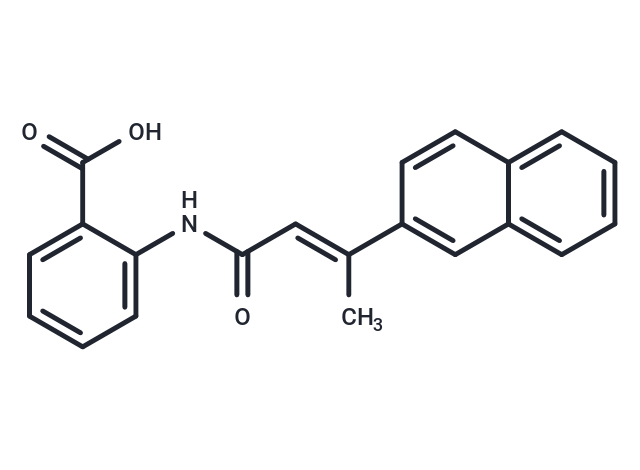Shopping Cart
- Remove All
 Your shopping cart is currently empty
Your shopping cart is currently empty

BIBR 1532 is an effective, specific and non-competitive telomerase inhibitor (IC50: 100 nM, in a cell-free assay).

| Pack Size | Price | Availability | Quantity |
|---|---|---|---|
| 5 mg | $45 | In Stock | |
| 10 mg | $81 | In Stock | |
| 25 mg | $147 | In Stock | |
| 50 mg | $265 | In Stock | |
| 100 mg | $479 | In Stock | |
| 500 mg | $1,080 | In Stock | |
| 1 mL x 10 mM (in DMSO) | $45 | In Stock |
| Description | BIBR 1532 is an effective, specific and non-competitive telomerase inhibitor (IC50: 100 nM, in a cell-free assay). |
| Targets&IC50 | Telomerase:100 nM |
| In vivo | In MCF-7/WT and melphalan-resistant MCF-7/MlnR cell lines, BIBR 1532 (2.5 μM) reduced colony-forming ability and shortened telomere length by inhibiting telomerase activity, and induced sensitization to chemotherapy. In vitro, BIBR 1532 dose-dependently and non-competitively inhibited telomerase activity (IC50: 100 nM).BIBR 1532 exhibited selective cytotoxicity against T-cell juvenile lymphoblastic leukemia in a dose-dependent manner.BIBR 1532-treated cells also showed nuclear condensation and apoptotic vesicle formation. In JVM13 leukemia cell line, BIBR 1532 showed a dose-dependent antiproliferative effect (IC50: 52 μM), and similar results were observed in other leukemia cell lines, including Nalm-1, HL-60 and Jurkat. In addition, BIBR 1532 showed an antiproliferative effect (IC50: 56 μM) in AML without affecting the proliferative capacity of normal hematopoietic stem cells. |
| Kinase Assay | Conventional Telomerase Assay : For the direct telomerase assay with the endogenous telomerase, 10 μL of telomerase-enriched extract is mixed with different concentrations of BIBR1532 in a final volume of 20 μL. After 15-minute preincubation on ice, 20 μL of the reaction mixture is added, and the reaction is initiated by transferring the tubes to 37 °C. The final concentrations in the reaction mixture are 25 mM Tris-Cl (pH 8.3), 1 mM MgCl2, 1 mM EGTA, 1 mM dATP, 1 mM dTTP, 6.3 μM cold dGTP, 15 μCi [α-32P]dGTP (3000 Ci/mmol; NEN), 1.25 mM spermidine, 10 units of RNasin, 5 mM 2-mercaptoethanol, and 2.5 μM TS-primer (5 |
| Cell Research | Cells are plated as triplicates in complete RPMI 1640 medium with various concentrations of BIBR1532. After 24 to 72 hours, water-soluble tetrazolium (WST-1) is added, which is transformed into formazan by mitochondrial reductase systems. The increase in the number of viable cells results in an increase of activity of mitochondrial dehydrogenases, leading to an increase of formazan dye formed, which is quantified by ELISA reader after 2, 3, and 4 hours of incubation. (Only for Reference) |
| Molecular Weight | 331.36 |
| Formula | C21H17NO3 |
| Cas No. | 321674-73-1 |
| Smiles | C\C(=C/C(=O)Nc1ccccc1C(O)=O)c1ccc2ccccc2c1 |
| Relative Density. | 1.285g/cm3 |
| Storage | Powder: -20°C for 3 years | In solvent: -80°C for 1 year | Shipping with blue ice. | |||||||||||||||||||||||||||||||||||
| Solubility Information | DMSO: 21.67 mg/mL (65.39 mM) Ethanol: 8.3 mg/mL (25 mM) | |||||||||||||||||||||||||||||||||||
Solution Preparation Table | ||||||||||||||||||||||||||||||||||||
Ethanol/DMSO
DMSO
| ||||||||||||||||||||||||||||||||||||

Copyright © 2015-2024 TargetMol Chemicals Inc. All Rights Reserved.